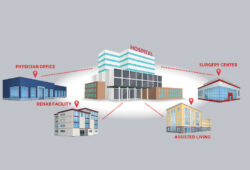BMC invests in high-performance teams for surgical specialties
When Boston Medical Center (BMC) received a grant in 2019 for its implementation of a high-performance team (HPT) in its vascular surgery service line, the 514-bed academic medical center planned on using the grant to kickstart an expansion of HPTs to all its surgical specialties. The coronavirus pandemic disrupted those plans, but it didn’t put a stop to them. Now, the race is back on.
A running start

Several years ago, in its continuous effort toward quality improvement, BMC leadership decided to focus on the surgery department. BMC leaders recognized that having highly specialized, dedicated teams for specific service lines would result in improved OR outcomes, so they piloted an HPT in vascular surgery, says Pamela Rosenkranz, MEd, BSN, RN, Senior Clinical Quality & Patient Safety Director of Surgery at BMC and Assistant Professor of Surgery at Boston University.
The vascular surgery HPT pilot was a huge success. Surgical site infections went down, a checklist for the surgeons that standardizes surgical prep procedures was developed, and efficiencies were created. One included the creation of a vascular surgery cart that had all the necessary materials, which reduced the number of times team members left the OR to retrieve supplies.
The vascular surgery HPT used simulation lab training to work through new processes and met every other week. Those regular meetings included time for social interaction, which transformed the team dynamic, as team members spent more time getting to know and trust each other. “It wasn’t just the surgeon who had a voice; everybody in that room had a voice because, at that meeting, they were on the same level,” Rosenkranz explains.
With the success of the vascular surgery HPT, the goal became to create HPTs for every surgical specialty. However, as a safety-net hospital, BMC didn’t have many extra resources to put toward the development of HPTs for every service line. But that changed when BMC received a grant that gave the team not only resources but the incentive to keep moving forward, Rosenkranz explains.
With a goal of creating an additional six surgical HPTs, leadership started the team development incrementally. The plan was to launch the first three immediately and add the remaining three in March 2020, but complications arose.
Hitting some hurdles
The coronavirus shutdown in March 2020 halted all elective surgeries and derailed further progress on the development of the HPTs. The kickoff meeting was postponed, and the monthly in-person team meetings went virtual.

Other challenges got in the way. The new HPTs were combined specialties because there wasn’t enough staff to have dedicated teams for each one. Among the challenges they faced was being able to identify which staff members had the right skill set for a particular team and then scheduling those people when their teams were in the OR, says Ingrid Rush, Clinical Quality Improvement and Patient Safety Specialist.
Rush recognized the need for a way to easily identify available staffing resources for more efficient and effective daily team member assignments. “We created an enhanced staffing grid in the electronic health record that displays all the staff’s shifts, teams and skills, which is used to make daily assignments for the OR schedule,” she says.
In a follow-up project, HealthTrust engineers are assisting nurse schedulers in anticipating staffing needs with a dashboard, launching soon. “This is being done in hopes that in the future, staff will voluntarily assign themselves on the day that their team is working,” Rush explains.
Long-term wins
One of the most thrilling benefits of using HPTs in the surgery department has been seeing a crisis debriefing tool developed by one team picked up by other teams, say Rush and Rosenkranz. Rush’s favorite example of this is a debriefing process created by the trauma/acute care/pediatrics HPT for when the team faces an emotionally devastating case.
During this process, the team meets to talk about what happened. A social worker with a background in crisis management and a team member with a dog who participates in BMC’s Healing Pups program are on hand to help everyone work through the difficult experience. Other teams, such as surgical oncology, have begun adopting the trauma/acute care/pediatric team’s process, says Rush. “It’s been a really good project,” Rush adds. “We’re just trying to establish mechanisms to keep it sustainable.”
There’s more to be excited about. In the fall of 2021, the launch event that had to be postponed in March 2020 finally took place for all six new HPTs, and the teams are back to monthly in-person meetings, says Rosenkranz.
BMC is using surgical outcomes data to measure how the HPTs are doing, but, at this point, the teams are too new for enough information to have accrued to provide usable data, Rosenkranz says. Still, they’ve learned a lot, in particular, that HPTs are a continuous process. “It’s not like you start this and it’s done; it remains a work in progress,” she says. “All these processes with data and outcomes, and offering continuing education during the monthly in-person meetings, is to create a culture of safety. That’s the overall goal. That’s what these teams will do.”
Share Email OR, Q1 2022, Staffing, Surgery




